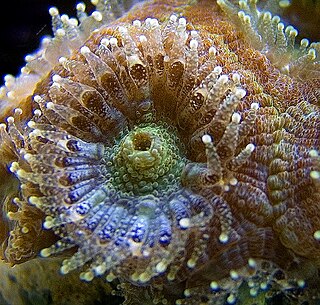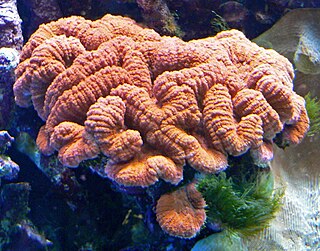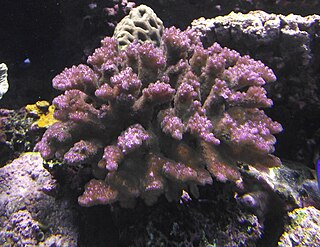
Acanthastrea echinata, commonly known as the starry cup coral, is a species of corals in the family Lobophylliidae. It is a wide-ranging species found from the western Indian Ocean, throughout the Pacific Ocean, and eastward to the southeastern Atlantic Ocean. It can inhabit any reef habitat to depths of 50 m. This species, which may become threatened with the global decline of coral reefs, is a popular coral used in aquariums.
Acanthastrea brevis is a vulnerable species of stony coral found in reef habitats at depths of 1–20 m. It is threatened by habitat loss and crown-of-thorns starfish predation. It is particularly susceptible to coral bleaching and ocean acidification.

Plerogyra sinuosa is a jelly-like species of the phylum Cnidaria. It is commonly called "bubble coral" due to its bubbly appearance. The "bubbles" are grape-sized which increase their surface area according to the amount of light available: they are larger during the day, but smaller during the night, when tentacles reach out to capture food. This species requires low light and a gentle water flow. Common names for Plerogyra sinuosa include "grape coral", bladder coral, pearl coral and branching bubble coral. According to the IUCN, Plerogyra Sinuosa ranges from the Red Sea and Madagascar in the eastern Indian Ocean to Okinawa and the Line Islands in the Pacific.

Micromussa lordhowensis, previously known as the 'Acan Lord', is a species of stony coral in the family Lobophylliidae. It is a widespread and common coral with large polyps occurring on shallow reefs in the Indo-Pacific Ocean. It was originally classified under the genus Acanthastrea, and reclassified under the genus Micromussa in 2016.

Lobophyllia hemprichii, commonly called lobed brain coral, lobed cactus coral or largebrain root coral, is a species of large polyp stony coral in the family Lobophylliidae. It is found in the Indo-Pacific Ocean. In its specific name Christian Gottfried Ehrenberg honoured his late partner the Prussian naturalist Wilhelm Hemprich; they were among the first to study the marine life of the Red Sea.

Pocillopora verrucosa, commonly known as cauliflower coral, rasp coral, or knob-horned coral, is a species of stony coral in the family Pocilloporidae. It is native to tropical and subtropical parts of the Indian and Pacific Oceans.

Micromussa regularis is a species of coral found in Indo-Pacific waters from Australia to the western Pacific Ocean. It is usually uncommon throughout its range, but can be more common locally. It has a narrow depth range, and so is susceptible to coral bleaching and disease. It is also threatened by the global decline in coral reef habitats.
Acanthastrea rotundoflora is a species of coral found in Indo-Pacific waters from the Red Sea to Australia and the East China Sea. The species in uncommon throughout its range, and is threatened by the global loss of coral reef habitats.
Acropora lovelli is a species of acroporid coral found in the northern Indian Ocean, the central Indo-Pacific, Australia and the oceanic west Pacific Ocean. It can also be found in Palau and the southern Mariana Islands, the Red Sea, Mauritius, Tuha'a Pae, the Pitcairn Islands and Rodrigues. It occurs in shallow tropical reefs, in shallow protected lagoons and at lagoon entrances, to depths from 1–10 m.
Acropora subglabra is a species of acroporid coral found in the northern Indian Ocean, the central Indo-Pacific, Australia, Southeast Asia, Japan, the East China Sea and the oceanic west Pacific Ocean. It occurs in tropical shallow reefs, and its range is often restricted to sheltered back reefs containing soft substrates and clear water. It can be found from depths of 5 to 15 metres and was described by Brook in 1891.
Alveopora fenestrata is a species of stony coral that is found in the Red Sea, the Gulf of Aden, the southwest and northern Indian Ocean, the central Indo-Pacific, Australia, Southeast Asia and the oceanic west Pacific Ocean. It can be found in shallow coral reefs, to a depth of 30 metres (100 ft). It is particularly susceptible to coral bleaching.

Alveopora spongiosa is a species of stony coral that is found in the Red Sea, the Gulf of Aden, the southwest and northern Indian Ocean, the central Indo-Pacific, Australia, Southeast Asia Japan, the East China Sea and the oceanic west and central Pacific Ocean. It can be found on protected upper coral reef slopes, generally from depth of 9–20 m, but can grow at depths of up to 50 m. It is moderately susceptible to coral bleaching, and is harvested for the aquarium trade.
Alveopora verrilliana is a species of stony coral that is found in the Red Sea, the Gulf of Aden, the northern Indian Ocean, the central Indo-Pacific, Australia, Southeast Asia, Japan, the East China Sea, the oceanic west and central Pacific Ocean and the Johnston Atoll. It can also be found in Palau and the southern Mariana Islands. It grows on shallow coral reefs to a depth of 30 metres (100 ft). It is particularly susceptible to coral bleaching and is harvested for the aquarium trade.

Goniastrea retiformis is a species of stony corals in the family Merulinidae. It is native to shallow water in the Indo-Pacific region.
Turbinaria radicalis, also known as disc coral, is a species of colonial stony coral in the family Dendrophylliidae. It is native to the central Indo-Pacific, tropical and sub-tropical Australia, the South China Sea, northern Australia and the West Pacific. It is a zooxanthellate coral that houses symbiont dinoflagellates in its tissues. It is a rare coral throughout its range and the International Union for Conservation of Nature has rated its conservation status as being "near-threatened".

Favites pentagona is a species of stony coral in the family Merulinidae, sometimes known as larger star coral. It is native to the Indo-Pacific region and its range extends from the Red Sea through the Indian Ocean to the Western Pacific Ocean. This is a common species throughout its wide range and the International Union for Conservation of Nature has rated its conservation status as being of "least concern".

Montipora grisea is a small polyped stony coral in the family Acroporidae.
Acropora rudis is a species of acroporid coral found in the Indo-Pacific region. It is an uncommon species and is classified by the International Union for Conservation of Nature as an endangered species because it is particularly susceptible to coral bleaching, coral diseases, damage by the crown-of-thorns starfish and destruction of its coral reef habitat.
Acropora derawanensis is a species of acroporid coral found in the eastern Indian Ocean and the west central Pacific Ocean. It is particularly susceptible to coral bleaching, disease, and crown-of-thorns starfish predation.

Dipsastraea pallida is a species of colonial stony coral in the family Merulinidae. It is found in tropical waters of the Indian and Pacific Oceans. This is a common species of coral with a widespread distribution, and the main threat it faces is from the destruction of its coral reef habitats. It is rated as a "least-concern species" by the International Union for Conservation of Nature. This species was first described in 1846 as Favia pallida by the American zoologist James Dwight Dana; it was later transferred to the genus Dipsastraea, but some authorities continue to use the original name.











